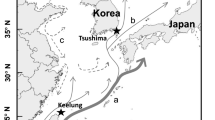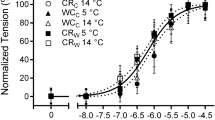Summary
Gonad output, reproductive effort and residual reproductive value are greater in scallops (Placopecten magellanicus) from shallow water, where conditions are more favourable, than in scallops from deep water. Variation between years in these fitness correlates is also greater in shallow water scallops. High reproductive effort is associated with a greater reproductive cost, although in general reproduction in this species appears to be “restrained”, and only in older individuals from shallow water is there evidence of “reckless” reproductive behaviour. Reproductive effort increases as the animal grows older, but residual reproductive value is a maximum at age 4 years, after which it decreases with age owing to greater mortality. Localities vary in their suitability for scallop growth and reproduction, and at one Newfoundland site conditions in shallow water (10 m) are better than those in deep water (31 m). Scallops from the former have a greater fitness than those from the latter. The energy costs of reproduction have implications for life history variability in P. magellanicus, although for a considerable part of its lifetime the scallop is able to maximise gamete production in response to environmental factors (especially the food supply) without trading off reproduction against growth or maintenance.
Similar content being viewed by others
References
Barnes H, Heath JR (1966) The extraction of glycogen from marine invertebrate tissues. Helgolander wiss. Meeresunters. 13:115–117
Bayne BL (1984) Aspects of reproductive behaviour within species of bivalve molluscs. In: Engels W (ed), Advances in invertebrate reproduction, vol III. Elsevier, Amsterdam, pp 357–366
Bayne BL, Holland DL, Moore MN, Lowe DM, Widdows J (1978) Further studies on the effects of stress in the adult on eggs of Mytilus edulis. J mar biol Ass U K 58:825–841
Bayne BL, Salkeld PN, Worrall CM (1983) Reproductive effort and value in different populations of the marine mussel Mytilus edulis L. Oecologia (Berlin) 59:18–26
Bayne BL, Worrall CM (1980) Growth and production of mussels, Mytilus edulis from two populations. Mar Ecol Prog Ser 3:317–328
Bell G (1984) Measuring the cost of reproduction. I. The correlation structure of the life table of a plankton rotifer. Evolution 38:303–313
Calow P (1979) The cost of reproduction: A physiological approach. Biol Rev 54:23–40
Calow P (1983) Life cycle patterns and evolution. In: Russell-Hunter WD (ed) The Mollusca, vol 6. Academic Press, New York, pp 649–678
Calow P, Woollhead AS (1977) The relationship between ration, reproductive effort and age-specific mortality in the evolution of life history strategies: Some observations on freshwater triclads. J Anim Ecol 46:765–781
Charlesworth B, Leon JA (1976) The relation of reproductive effort to age.. Am Nat 110:449–459
Dubois M, Gilles KA, Hamilton JK, Rebers PA, Smith F (1956) Colorimetric method for the determination of sugars and related substances. Anal Chem 28:350–356
Goodman D (1979) Regulating reproductive effort in a changing environment. Am Nat 113:735–748
Goodman D (1982) Optimal life histories, optimal notation and the value of reproductive value. Am Nat 119:803–823
Haukioja E, Hakala T (1978) Life-history evolution in Anodonta piscinalis (Mollusca, Pelecypoda). Oecologia (Berlin) 35:253–266
Hawkins AJS (1983) Metabolic strategy in the marine mussel, Mytilus edulis L. Unpubl PhD Thesis, University of Exeter, UK
Hirshfield MF (1980) An experimental analysis of reproductive effort and cost in the Japanese medaka, Oryzias latipes. Ecology 61:282–292
Hirshfield MF, Tinkle DW (1975) Natural selection and the evolution of reproductive effort. Proc Nat Acad Sci 72:2227–2231
Hughes RN (1970) An energy budget for a tidal-flat population of the bivalve Scrobicularia plana (da Costa). J Anim Ecol 39:357–379
Hughes RN, Roberts DJ (1980) Reproductive effort of winkles (Littorina spp) with contrasted methods of reproduction. Oecologia (Berlin) 47:130–136
Kautsky N (1982) Quantitative studies on gonad cycle, fecundity, reproductive output and recruitment in a Baltic Mytilus edulis population. Mar Biol 38:143–160
Lucas A, Calvo J, Trancort M (1978) L'effort de reproduction dans la strategie demographique de six bivalves de l'Atlantique. Haliotis 9:107–116
MacDonald BA, Thompson RJ (1985a) Influence of temperature and food availability on the ecological energetics of the giant scallop Placopecten magellanicus. I. Growth rates of shell and somatic tissue. Mar Ecol Prog Ser 25:279–294
MacDonald BA, Thompson RJ (1985b) Influence of temperature and food availability on the ecological energetics of the giant scallop Placopecten magellanicus. II. Reproductive output and total production. Mar Ecol Prog Ser 25:295–303
MacDonald BA, Thompson RJ (1986a) Influence of temperature and food availability on the ecological energetics of the giant scallop Placopecten magellanicus. III. Physiological ecology, the gametogenic cycle and scope for growth. Mar Biol 93:37–48
MacDonald BA, Thompson RJ (1986b) Production dynamics and energy partitioning in two populations of the giant scallop Placopecten magellanicus (Gmelin). J Exp Mar Biol Ecol 101:285–299
Mantyla K (1981) Pikkujarvisimpukan (Anodonta piscinalis) (Nilsson) jalkelaistuotto ja lissantymispanos. MSc thesis, University of Turku (cited in Tuomi et al. 1983)
Menge BA (1974) Effect of wave action and competition on brooding and reproductive effort in the seastar, Leptasterias hexactis. Ecology 55:84–93
Reznick D (1985) Costs of reproduction: an evaluation of the empirical evidence Oikos 44:257–267
Rodhouse PG, Roden CM, Hensey MP, Ryan TH (1985) Resource allocation in Mytilus edulis on the shore and in suspended culture. Mar Biol 84:27–34
Shafee MS, Lucas A (1980) Quantitative studies on the reproduction of the black scallop Chlamys varia (L.) from Lanevoc area (Bay of Brest). J exp mar Biol Ecol 42:171–186
Shafee MS, Lucas A (1982) Variations saisonnieres du bilan energetique chez les individus d'une population de Chlamys varia (L.): Bivalvia, Pectinidae. Oceanologica Acta 5:331–338
Spight TM, Emlen J (1976) Clutch sizes of two marine snails with a changing food supply. Ecology 57:1162–1178
Stearns SC (1976) Life-history tactics: A review of the ideas. Quart Rev Biol 51:3–47
Stearns SC (1980) A new view of life-history evolution. Oikos 35:266–281
Thompson RJ (1979) Fecundity and reproductive effort in the blue mussel (Mytilus edulis), the sea urchin (Strongylocentrotus droebachiensis) and the snow crab (Chionoecetes opilio) from populations in Nova Scotia and Newfoundland. J Fish Res Bd Can 36:955–964
Thompson RJ (1983) The relationship between food ration and reproductive effort in the green sea urchin, Strongylocentrotus droebachiensis. Oecologia (Berlin) 56:50–57
Thompson RJ (1984) Production, reproductive effort, reproductive value and reproductive cost in a population of the blue mussel Mytilus edulis from a subarctic environment. Mar Ecol Prog Ser 16:249–257
Tuomi J, Hakala T, Haukioja E (1983) Alternative concepts of reproductive effort, costs of reproduction and selection in lifehistory evolution. Am Zool 23:25–34
Vahl O (1981a) Age-specific residual reproductive value and reproductive effort in the Iceland scallop, Chlamys islandica (O.F. Muller). Oecologia (Berlin) 51:53–56
Vahl O (1981b) Energy transformations by the Iceland scallop, Chlamys islandica (O.F. Muller), from 70°N. I. The age-specific energy budget and net growth efficiency. J exp mar Biol Ecol 53:281–296
Williams GC (1966) Natural selection, the cost of reproduction and a refinement of Lack's principle. Am Nat 100:687–690
Author information
Authors and Affiliations
Rights and permissions
About this article
Cite this article
MacDonald, B.A., Thompson, R.J. & Bayne, B.L. Influence of temperature and food availability on the ecological energetics of the giant scallop Placopecten magellanicus . Oecologia 72, 550–556 (1987). https://doi.org/10.1007/BF00378981
Received:
Issue Date:
DOI: https://doi.org/10.1007/BF00378981




